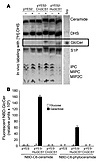Citations to this article
Citation Information: J Clin Invest. 2006;116(6):1651-1659. https://doi.org/10.1172/JCI27890.
Abstract
The pathogenic fungus Cryptococcus neoformans infects humans upon inhalation and causes the most common fungal meningoencephalitis in immunocompromised subjects worldwide. In the host, C. neoformans is found both intracellularly and extracellularly, but how these two components contribute to the development of the disease is largely unknown. Here we show that the glycosphingolipid glucosylceramide (GlcCer), which is present in C. neoformans, was essential for fungal growth in host extracellular environments, such as in alveolar spaces and in the bloodstream, which are characterized by a neutral/alkaline pH, but not in the host intracellular environment, such as in the phagolysosome of macrophages, which is characteristically acidic. Indeed, a C. neoformans mutant strain lacking GlcCer did not grow in vitro at a neutral/alkaline pH, yet it had no growth defect at an acidic pH. The mechanism by which GlcCer regulates alkali tolerance was by allowing the transition of C. neoformans through the cell cycle. This study establishes C. neoformans GlcCer as a key virulence factor of cryptococcal pathogenicity, with important implications for future development of new antifungal strategies.
Authors
Philipp C. Rittershaus, Talar B. Kechichian, Jeremy C. Allegood, Alfred H. Merrill, Mirko Hennig, Chiara Luberto, Maurizio Del Poeta
Total citations by year

Citations to this article in year 2022 (3)
| Title and authors | Publication | Year |
|---|---|---|
|
Three Models of Vaccination Strategies Against Cryptococcosis in Immunocompromised Hosts Using Heat-Killed Cryptococcus neoformans Δsgl1
Normile TG, Del Poeta M |
Frontiers in immunology | 2022 |
|
An Immunogenic and Slow-Growing Cryptococcal Strain Induces a Chronic Granulomatous Infection in Murine Lungs
Telzrow CL, Esher Righi S, Castro-Lopez N, Campuzano A, Brooks JT, Carney JM, Wormley FL Jr, Alspaugh JA |
Infection and immunity | 2022 |
|
Lipid Transport by Candida albicans Dnf2 Is Required for Hyphal Growth and Virulence.
Jain BK, Wagner AS, Reynolds TB, Graham TR |
Infection and immunity | 2022 |



Copyright © 2025 American Society for Clinical Investigation
ISSN: 0021-9738 (print), 1558-8238 (online)

